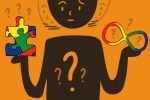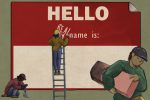Nonverbal learning disorder isn’t very common, but its impact on the lives of those who do have it is worth talking about. Studies estimate that around 1% of kids in the United States have Nonverbal Learning Disorder. That number might be higher because sometimes the disorder isn’t diagnosed correctly the first time. NLD is often mistaken for ADHD, as they have some of the same symptoms. I was diagnosed with NLD when I was 5 years old and have had to deal with the challenges it presents, especially when attending college.
What Is NLD?
Nonverbal learning disorder is a brain-based disability characterized by a significant discrepancy between high verbal, weak motor, visual-spatial and social skills. The most common symptoms of NLD are having trouble recognizing nonverbal cues such as facial expressions and body language, difficulty with visual learning and challenges using fine motor skills. People with NLD find it difficult understanding communication that isn’t verbal.
The disorder usually begins showing at a very early age, and can be diagnosed as early as kindergarten. Experts don’t know what exactly causes NLD, but it has something to do with how the brain sends signals between the right and left sides. There could be a deficit in the right cerebral hemisphere of the brain where nonverbal processing occurs. There’s no hereditary cause, as NLD does not run in families like many other learning disabilities.
NLD is not simple to diagnose and takes an expert on the disability to accurately diagnose it in a child. You can’t tell if someone has NLD just because they’re bad at math; there’s a myriad of symptoms that go together and make up the diagnosis of the disorder. If children aren’t diagnosed early, the symptoms will only get worse and follow them further into their education.
How NLD Affects Everyday Life
I wish having nonverbal learning disorder only meant I was below average on my math skills, but the disorder causes many more challenges than that. When you have NLD, you experience its obstacles beginning in primary school.
It was extremely difficult to make and keep friends in elementary and middle school because I couldn’t understand nonverbal cues, like body language and facial expressions. It’s like everyone else was given a handbook on how to translate nonverbal communication except for me. Classmates don’t want to associate with you if you’re seen as awkward or unable to communicate effectively, even if you can’t help it.
There are some smaller, more specific symptoms of NLD that also affect life in and out of school. People with NLD have a hard time adapting to change and that’s why they often do worse and worse as they go further in their education. A child that did well in primary school because of their above average verbal skills may fall exponentially behind in secondary school due to the inability to adapt to change.
This isn’t to say that kids with NLD aren’t bright, because they usually are. They just have challenges they need to overcome that other kids don’t have. Another specific symptom is processing information more slowly than most students. I’ve needed extra time on tests and quizzes since high school, and still get extra time in college. All these symptoms of NLD combined make for difficulties not only in school, but in your social and family life as well.
Living with NLD In College
Going to college knowing I had diagnosed NLD was an incredibly scary situation, and I wasn’t sure how I would handle the new social or educational environment. Luckily, I went to a high school that accommodated my learning disability with an Individualized Education Program, so I was able to excel despite having the disorder. Despite this plus side to having NLD in high school, the struggles making and keeping friends persisted until my senior year, which took a toll on my self-esteem.
Despite being full of anxiety and certain my NLD would ruin the college experience for me, I sought help at the learning commons of my university, and it was the best decision I could have made. I still had a hard time making many friends due to inevitably misunderstanding social cues, but I have learned to compensate for my social discrepancies through cognitive behavioral therapy.
I get extra time at the learning commons for tests and quizzes, and I happen to go to a university that accommodates my disability quite well. I understand not everyone who has NLD and goes to school gets the help they need, but I hope to spread awareness about how serious NLD is as a learning disability and encourage those who have it to seek any services available that can help. It’s almost impossible to succeed in an educational setting without learning services.
Recognition for NLD
I’ve had nonverbal learning disorder since I can remember; when I was 5 it was first mistaken for ADHD and then the correct diagnosis was made shortly after. This is the case for many people who have NLD. It can’t be cured, but you can get accommodations for it and learn to compensate for the weaknesses caused by the disability.
The symptoms of NLD do not go away with age but worsen and cause more challenges. Getting diagnosed is the most important step to getting help and learning how to deal with the disability. Often nonverbal learning disorder causes anxiety because of the trouble with social situations and education, so the earlier someone is diagnosed, the sooner they can find effective strategies and treatment.
Living with NLD in college is no easy task, but it’s reassuring if someone with the disability got through high school and was able to get into college. The best way for a person with NLD to succeed in high school and college is to have some sort of educational service for learning disabilities. This could be an Individualized Education Program or a Section 504 plan.
Although awareness about NLD is spreading, it is still not recognized as a disability covered by the Diagnostic and Statistical Manual of Mental Disorders (DSM-5). There needs to be better recognition of this disability because it affects both children and adults and is a constant obstacle. It can cause children to have difficulties making friends and creating a social life, as well as keep them from succeeding in school.
Nonverbal learning disorder has even worse consequences for adults when they realize they can’t perceive social situations but don’t know what to do about it. We need to recognize NLD and deem it an official learning disability so children and adults can get the help in all aspects of their lives.
















